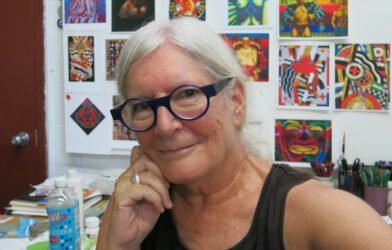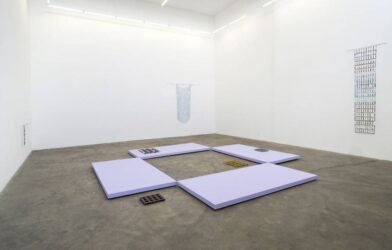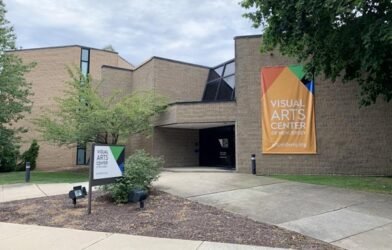ARTIST Nick Schlee is entranced by the movement of water.
The nonagenarian has just opened an exhibition called “Looking at Water” at the River & Rowing Museum in Henley, featuring his paintings of waterways, including the River Thames and the River Pang.
Nick has lived in Upper Basildon for more than three decades and has four children from his marriage to Ann, a novelist, who died in November.
Born in 1931, he joined a London advertising agency after leaving school, then did his national service before returning.
He went on to study English at Oxford, where he met Ann.
After spending some time in New York, he went to the Central School of Art and Design, Morley College, Putney Art School and the Slade School of Fine Art in London. He has been staging solo exhibitions since 1987.
Nick has been through a tumultuous few years. In 2021, a fire destroyed the couple’s home and studio.
He says: “After our whole house burnt down, because we were so old, the priority was to get the house built again on the same spot, you know, so that in your declining years you’re not living somewhere where you don’t know.
“We achieved that — it was built in 34 weeks and it’s magnificent.”
Nick and Ann worked with Matthew Lloyd Architects on a redesign of the house using the original footprint.
“As it was, because it was a 1951 house, it wasn’t up to standard,” says Nick.
“Luckily, my godson was an architect and I knew his father, who was an architect whose father was also an architect.
“He’s in London and he has won a couple of prizes. He came out and built this magnificent house and it’s like living in the south of France or Italy.
“Luckily, it is on exactly the same spot so we didn’t disturb the garden at all.
“Although my wife only had a year and a quarter in it, everything was totally familiar and the layout of the house was the same too and that was nice.”
After the fire, the couple’s daughter-in-law found some temporary accommodation for them in Pangbourne, where Nick found solace in capturing the waterside setting.
“We stayed there for a year and a half,” says Nick. “It was wonderful place, about 20 yards from the riverbank at Pangbourne weir. Every morning we could look out at the changing scene.
“If we walked 100 yards to the left we could see the Pang, which was a fast-moving stream coming down and joining the slow-moving Thames, and at certain times of the day the light sort of spun off it.
“There was also a backwater with a bridge going across it. The river rushed towards where you’re standing and it was all still at the back so it was a nice contrast.
“It was so moving, so exciting, that I felt, well, this is a jolly subject matter to have thrust upon you.
“I did some normal [paintings] just looking at the scenery and the trees but more interesting to me was this movement of the water.
“I have done my best to make marks that suggest those agitating movements. The result is a chaos of colours and unpredictable curves. There are no lines in nature.”
Nick liked to sketch the flowing water before creating larger
versions.
He says: “You have to decide what you’re going to paint but of course if it moves all the time you don’t know what the devil you’re going to put down. As soon as you look back, what you were going to put down has gone and moved somewhere else.
“I have tried to recreate the excitement that my eye had moving about with the picture. If you’re not excited by what you’re looking at, you can’t possibly make a picture that excites other people.
“A couple of the tools of the trade of an artist include colour, which is one of the main things for exciting people, and the other is movement and rhythm in a linear way, to take your eye across the picture and around it.
“The trick is to see if you can reproduce the excitement that’s in the sketch done on the spot, say, maybe two weeks, two months or even two years later, in a much larger oil painting. What normally happens is that people copy what a camera does, which is just to take a flash second and freeze it and as a result you have to imagine the movement with your experience of water.
“Well, I haven’t done that. What I’ve done is just to let the eye zigzag and swirl around the movement that there is in the hope of giving a more honest picture of what your eye experiences when you’re looking at the water.”
Nick and Ann enjoyed living close to the river.
“It was so nice to be near the shops and things,” he says. “My wife was in a wheelchair for 12 years so I was able to take her shopping and that sort of thing and we used to picnic by the edge of the water at every opportunity because what better can you do? I don’t know. We had a very good time there.”
Even so, he is glad to be back in his new home.
Nick says: “The sun didn’t come into our old place because it faced north but we have a whole raft of 8ft clear windows all down the south side of our rebuilt house.
“It gathers the sun at different times of the day past all the trees we’ve got in the garden. It’s a really good place.”
• “Looking at Water” is at the River & Rowing Museum until July 31. The museum is open Thursday to Monday from 10am to 4pm (open seven days a week in school holidays). For more information, visit www.nickschlee.co.uk or rrm.co.uk/whats-on









